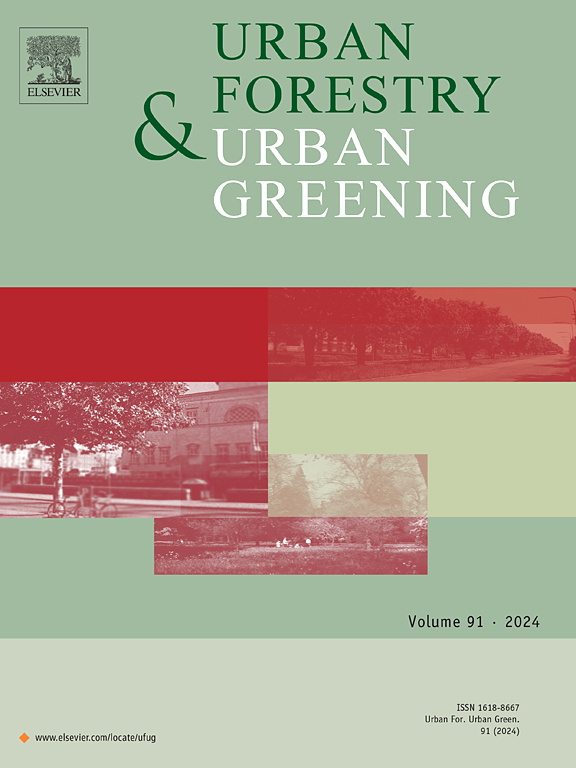Deep compost amendment reduces soil bulk density resulting in improved growth of urban Gymnocladus dioicus trees over time
IF 6
2区 环境科学与生态学
Q1 ENVIRONMENTAL STUDIES
引用次数: 0
Abstract
It is well known that trees provide many benefits in the urban environment, including temperature reduction, carbon sequestration, pollution remediation and storm water reduction. What is less well known are the best methods to use when establishing urban trees to ensure maximized growth and ecosystem services. We examined how amending soil prior to planting by incorporating a compost deep in the soil profile influenced the growth of Kentucky coffeetrees (Gymnocladus dioicus L Koch ‘Espresso’) planted along a boulevard in the city of Ithaca, NY, USA. We found that amendment reduced soil compaction, as indicated by a soil penetrometer, and bulk density, compared to sites without soil amendment. Amended soils exhibited higher water holding capacities, soil respiration values, as well as organic matter, soil protein, total nitrogen, total carbon and organic carbon contents. Compared to trees growing on sites without amendment, trees planted in amended soils exhibited larger trunk diameters, increased canopy height, longer shoots and leaves, increased leaf areas and leaf greenness, as well as more roots overall and roots growing deeper in the soil profile. Soil amendment prior to tree planting could be a useful technique for improving the vitality of urban trees and their subsequent ecosystem services in cities worldwide.
随着时间的推移,深层堆肥改良剂降低了土壤容重,从而改善了城市裸子树的生长
众所周知,树木在城市环境中提供了许多好处,包括降低温度、固碳、修复污染和减少雨水。不太为人所知的是在建立城市树木时使用的最佳方法,以确保最大限度地增长和生态系统服务。我们研究了种植前如何通过在土壤剖面中加入堆肥来改善土壤,影响肯塔基咖啡树(Gymnocladus dioicus L Koch ' Espresso ')沿着美国纽约州伊萨卡市的一条林荫大道种植的生长。我们发现,与没有土壤改良剂的地点相比,土壤改良剂减少了土壤压实度,正如土壤渗透仪所显示的那样。改良土壤的持水能力、土壤呼吸值、有机质、土壤蛋白质、全氮、全碳和有机碳含量均有所提高。与未进行土壤改良的树木相比,土壤改良后的树木树干直径更大,冠层高度增加,嫩芽和叶片更长,叶面积和叶片绿度增加,根系总体更多,根系在土壤剖面中生长更深。在世界范围内,植树前的土壤改良是提高城市树木活力及其后续生态系统服务的一项有用技术。
本文章由计算机程序翻译,如有差异,请以英文原文为准。
求助全文
约1分钟内获得全文
求助全文
来源期刊

Urban Forestry & Urban Greening
FORESTRY-
CiteScore
11.70
自引率
12.50%
发文量
289
审稿时长
70 days
期刊介绍:
Urban Forestry and Urban Greening is a refereed, international journal aimed at presenting high-quality research with urban and peri-urban woody and non-woody vegetation and its use, planning, design, establishment and management as its main topics. Urban Forestry and Urban Greening concentrates on all tree-dominated (as joint together in the urban forest) as well as other green resources in and around urban areas, such as woodlands, public and private urban parks and gardens, urban nature areas, street tree and square plantations, botanical gardens and cemeteries.
The journal welcomes basic and applied research papers, as well as review papers and short communications. Contributions should focus on one or more of the following aspects:
-Form and functions of urban forests and other vegetation, including aspects of urban ecology.
-Policy-making, planning and design related to urban forests and other vegetation.
-Selection and establishment of tree resources and other vegetation for urban environments.
-Management of urban forests and other vegetation.
Original contributions of a high academic standard are invited from a wide range of disciplines and fields, including forestry, biology, horticulture, arboriculture, landscape ecology, pathology, soil science, hydrology, landscape architecture, landscape planning, urban planning and design, economics, sociology, environmental psychology, public health, and education.
 求助内容:
求助内容: 应助结果提醒方式:
应助结果提醒方式:


